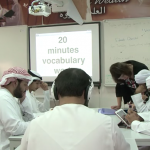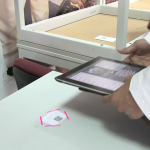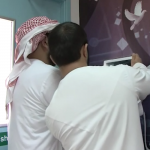Learning Objectives
To provide students with the vocabulary and language structures necessary to be able to describe a place they know and to recognize places described by peers in written descriptions.
21st Century Skills
- To foster the students ability to work through a set of exercises independently and to collaborate with fellow learners when they encounter difficulties.
- To encourage research skills and develop the students’ ability to know where to look for background information when necessary e.g. Students can use Google Maps and Wikipedia information to help them guess places their friends had written about.
- To provide an opportunity for students to self-evaluate and decide when they have learned something well enough to be able to complete a task.
- To encourage student organizational skills. Students need to get into pairs and groups and follow sets of written and spoken instructions. Students need to remember these instructions over a number of steps.
- Mobile Learning Skills
- To recognize the name of several WEB 2.0 tools and apps and be able to navigate between them, using appropriate passwords and reading iPad semiotics correctly.
- To use a QR reader efficiently in order to gain access to an answer key and the digital donations of fellow students.
Lesson plan
- Teacher gives an overview of the one hour lesson, setting learning targets in terms of communicative skills and how they add value to the students. This overview (boarded prior to the lesson) provides students with a choice of routes through the vocabulary stage of the lesson. It is advantageous to keep the workflow on a semi-permanent surface and not on the projected screen, so that everyone can refer to the overview throughout the lesson.
- Student choices are provided via Quizlet ( working at the word level) and Spelling City( working with words at the sentence level) this allows fast finishers to challenge themselves, and allows students to work on what they think is important for them. Links are provided via LMS such as Edmodo or emailed to students. Students can also sign into the app.(see the link below)
- Teacher to foster independence by asking students to look at the title on the board and find the appropriate app or exercise on their iPad, rather than opening up apps for students.
- Students have 20 minutes to work on vocabulary acquisition and sentence syntax. The Big Sign app facilitates time management.
5. The class is divided into 2 groups for the Dubai/ Abu Dhabi listening and language input stage. Podcasts were made using Audioboo.(see the link below
for the links and worksheets) Print out the worksheets so that students do not need to alternate between iPad panes which really hinders control of the audio recording.
6. Teacher breaks up the instructions for the listening phase of the lesson into steps. For example, she explains a step and gets students to locate the correct listening. An Explain Everything Screencast is used to illustrate the instructions.
7. Students listen to an audio description of a city and fill in the gaps. Podcasts are shared via an LMS or email. Students are able to listen to the podcast as many times as necessary. The gap filled words are from the vocabulary exercises. Answer keys are provided by QR Codes. Students need a QR code reader to be able to access the information. Students need to understand the information and be able to retell it in a pair work jigsaw listening and speaking exercise.
8. After getting new information from a jigsaw partner, students return to their original group and share the information they have gained. This provides them with a second chance to describe a place.
9. Teacher monitors and records recurring errors. Errors are to be boarded using different coloured pens to aid noticing and self-correction. Error correction work can be captured on Explain Everything or another screencasting tool and made available to students for future reinforcement.
10. In a previous lesson, students write descriptions of a secret place and email it to their teacher. They do not share the location of the place with anyone, creating a genuine information gap. The teacher saves the secret description into a URL generating site such as a public Google Drive folder or Files Everywhere. One URL is needed per description. The URL is used to create a QR Code for each location using a QR code generator such as QR stuff (http://www.qrstuff.com/ ) or Zxing ( http://zxing.appspot.com/generator/ ). QR codes are saved to Pictures on a laptop and printed out. Each QR code is named e.g. Place 1, Place 2 etc. It is important that the teacher writes down which student described which place for the place confirmation feedback slot. The labeled QRcodes are stuck around the classroom. Students armed with their iPads or mobile phones use a QR Code Reader to unlock the text and write the name of each place against its number on a list. Students are encouraged to use other mobile resources such as Google Maps to help them identify individual locations.
11. Teacher projects a list of which student wrote which description e.g. Ahmed =Place 1. The whole class share their location guesses and the author of the description confirms or corrects the guesses.
Overall Lesson Evaluation
The learning aims of the lesson were met as students were able to use the vocabulary from the review phase to complete the listening gap fill and in many cases they spelt the words correctly or were able to self-correct.
There was evidence of self and peer correction during the monologue phase. In reality, there was not a genuine information gap as students already know about the two cities described, and so the pair-work retelling and the group work recap were actually only at the classroom display level of communication. However, students were prepared to engage in this classroom specific behaviour in order to learn, and speaking about familiar places, for which they had substantial background knowledge, seemed to increase their confidence. The 21st century skills of collaborative learning and independent learning were definitely fostered in this lesson, and have been developed in previous lessons as most students were able to navigate between apps and between screens. Students moved between Google Maps, and some checked up which islands were next to Spain. The signs of students working independently at their own pace were that when some learners were reading the answer key, others were still working on Audioboo podcast. One fast finishers returned to the descriptions of the teacher’s secret place for the previous day to revise language structures, whilst another reviewed vocabulary on Quizlet. Students are learning to judge how much time they have during the hiatus between their finishing their work and beginning a whole class activity, and using the time slot to challenge themselves accordingly. This is major way on which m-learning adds value to the classroom. However, even though learners have been using Quizlet for 11 weeks, some students still cannot get into Spelling City without assistance because they do not type in the class name correctly. Two students opened up the first thing they saw in Edmodo. They did not read key words such as vocabulary or listening. I need to focus on these students at the beginning of activities and ask them guiding questions to help them be successful and internalize the digital sequences.
The QR Code Secret Place activity obviously got students interested and engaged. Students did not know who had written a description of which place and so did not try to short cut the reading by asking each other for names. Instead they read an average of 8 out of 12 texts each, with faster students reading all 12 texts. The weakest student read 6 texts. Two students were not present that day and we were not able to ascertain the correct location of their descriptions. The next day in class, as soon as these two students entered the room, others asked about their secret places. I saw this as proof that the students were genuinely motivated by the activity which challenged more than their language knowledge.
A key 21st century skill is to know who is an expert in what area and to know where to find information. I try to develop student interdependence by making them aware that others in the group are a source of knowledge and support by asking questions such as “Can anyone help him spell ……?”. I also help students to feel a valued, contributing member of a team by giving them responsibility for giving out handout worksheets, pencils etc. During the lesson, I made an error handing out worksheets and students immediately picked this up and informed me. This shows they are aware of what is happening and feel responsible for making things work efficiently, and I believe it is good to model a positive attitude to errors. Acknowledging the two mistakes I made, gives students the freedom to make mistakes themselves and to experiment and hypothesis test, an essential ingredient in collaborative group work and learning by doing. This is especially true in m-Learning where things are constantly changing, and during this lesson there were many examples of students helping each other with technology.
Resources
Vocabulary links:
Spelling City App, teacher ADMC Level1, Writing about cities. Sentence Unscramble (app only).
Quizlet http://quizlet.com/22602101/describing-cities-towns-and-villages-flash-cards/
Quizlet http://quizlet.com/22642928/describing-dubai-and-abu-dhabi-flash-cards/
Audioboo links for the podcasts.
http://audioboo.fm/boos/1031807-describing-abu-dhabi
http://audioboo.fm/boos/1031802-describing-dubai
Student 1: Describing Abu Dhabi
TASK ONE: Go to Edmodo- Describing Abu Dhabi Audioboo. Listen and fill in the gaps on this paper.
The capital of the United Arab Emirates is Abu Dhabi. Abu Dhabi means the 1. _____________ of the deer or gazelle. Abu Dhabi is 2. ____________________ in the center of the Emirati coast. Abu Dhabi is 3. _____________________________ the sea and the desert. Abu Dhabi is an 4. _________________________and the city is situated on the island and on the 5. ______________________. It is a very big city with a 6. ____________________________ of one million people. Abu Dhabi is famous because it was the 7. ________________ of Sheikh Zayed, the father of the U.A.E. It has a big 8._______________and a long beach called the Corniche. Abu Dhabi is a 9. __________. Lots of 10. _____________ stop in Abu Dhabi. In the past, Abu Dhabi was 11.________________ for pearls. Now, it is famous for shopping. There are lots of 12._______________________ malls such as Marina Mall and Al Wadha Mall. Abu Dhabi is a very 13.____________________ city with lots of wonderful buildings. The Emirates Palace is one of the best hotels in the 14._________________________.
TASK TWO: Read the description again. Underline Key words. You will tell a friend about Abu Dhabi.
Student 2: Describing Dubai
TASK ONE: Go to Edmodo- Describing Dubai Audioboo. Listen and fill in the gaps on this paper.
The second city of the United Arab Emirates is 1.____________. Dubai is situated on the Emirati 2._________________. Dubai is between the sea and the 3.__________________. It is not an island. It is on the 4.____________________. It is a big city with a population of a 5.________________ people. Dubai is famous because it is a 6.__________________ resort. It has many hotels and a long 7._______________ called Jumeriah Beach. Dubai is a 8.__________________. Lots and 9.________________ stop in Dubai. Now it’s famous for 10._________________. There are 11.__________________ shopping malls such as Mall of the Emirates. Dubai is a 12.__________________ city with many beautiful buildings. Khalifa Tower is the 13.____________________ building in the world.
Answer Key
TASK TWO: Read the description again. Underline Key words. You will tell a friend about Dubai.













